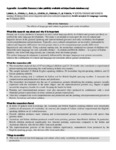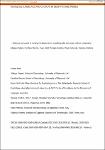Gestures and words in naming: Evidence from cross-linguistic and cross-cultural comparison
| dc.contributor.author | Cattani, Allegra | |
| dc.contributor.author | Floccia, Caroline | |
| dc.contributor.author | Kidd, E | |
| dc.contributor.author | Onofrio, D | |
| dc.contributor.author | Pettenati, P | |
| dc.contributor.author | Volterra, V | |
| dc.date.accessioned | 2019-03-12T15:23:20Z | |
| dc.date.issued | 2019-09 | |
| dc.identifier.issn | 0023-8333 | |
| dc.identifier.issn | 1467-9922 | |
| dc.identifier.other | 16452078 | |
| dc.identifier.uri | http://hdl.handle.net/10026.1/13454 | |
| dc.description | Summary file replaced (incorrect version) on 22/9/2022 by KT (LDS). | |
| dc.description.abstract |
We report on an analysis of spontaneous gesture production in 2-year-old children who come from three countries (Italy, UK and Australia) and whom speak two languages (Italian and English), in an attempt to tease apart the influence of language and culture when comparing children from different cultural and linguistic environments. Eighty-seven monolingual children aged 24-30 months completed an experimental task measuring their comprehension and production of nouns and predicates. The Italian children scored significantly higher than the other groups on all lexical measures. With regards to gestures, British children produced significantly fewer pointing and speech combinations compared to the Italian and Australian children, who did not differ from each other. In contrast, Italian children produced significantly more representational gestures than the two other groups. We conclude that spoken language development is primarily influenced by the input language over gesture production, whereas the combination of cultural and language environments affects gesture productions. | |
| dc.format.extent | 709-746 | |
| dc.language | en | |
| dc.language.iso | en | |
| dc.publisher | Wiley | |
| dc.subject | Pointing gesture | |
| dc.subject | Representational gesture | |
| dc.subject | Lexicon | |
| dc.subject | Crosscultural | |
| dc.subject | Crosslinguistic | |
| dc.subject | Language development | |
| dc.title | Gestures and words in naming: Evidence from cross-linguistic and cross-cultural comparison | |
| dc.type | journal-article | |
| dc.type | Journal Article | |
| plymouth.author-url | https://www.webofscience.com/api/gateway?GWVersion=2&SrcApp=PARTNER_APP&SrcAuth=LinksAMR&KeyUT=WOS:000478899900005&DestLinkType=FullRecord&DestApp=ALL_WOS&UsrCustomerID=11bb513d99f797142bcfeffcc58ea008 | |
| plymouth.issue | 3 | |
| plymouth.volume | 69 | |
| plymouth.publisher-url | https://onlinelibrary.wiley.com/doi/full/10.1111/lang.12346 | |
| plymouth.publication-status | Published | |
| plymouth.journal | Language Learning | |
| dc.identifier.doi | 10.1111/lang.12346 | |
| plymouth.organisational-group | /Plymouth | |
| plymouth.organisational-group | /Plymouth/00 Groups by role | |
| plymouth.organisational-group | /Plymouth/00 Groups by role/Academics | |
| plymouth.organisational-group | /Plymouth/Faculty of Health | |
| plymouth.organisational-group | /Plymouth/Faculty of Health/School of Psychology | |
| plymouth.organisational-group | /Plymouth/REF 2021 Researchers by UoA | |
| plymouth.organisational-group | /Plymouth/REF 2021 Researchers by UoA/UoA04 Psychology, Psychiatry and Neuroscience | |
| dcterms.dateAccepted | 2019-02-15 | |
| dc.rights.embargodate | 2020-5-1 | |
| dc.identifier.eissn | 1467-9922 | |
| dc.rights.embargoperiod | Not known | |
| rioxxterms.version | Accepted Manuscript | |
| rioxxterms.versionofrecord | 10.1111/lang.12346 | |
| rioxxterms.licenseref.uri | http://www.rioxx.net/licenses/all-rights-reserved | |
| rioxxterms.licenseref.startdate | 2019-09 | |
| rioxxterms.type | Journal Article/Review |



